You’re in the right place if your current B2B website strategy is:
- Underperforming: You’re getting traffic, but not the right kind, and conversions are flat.
- Overcomplicated: Too many goals, confusing navigation, and content that tries to please everyone but ends up pleasing no one.
- Struggling with the 2026 B2B buyer: Missing buyer enablement, third-party proof, or clear ROI messaging.
In this blog, we’ll walk you through CONVERT X, ThunderClap’s 8-step framework to optimize your current B2B website strategy for better conversions and stronger alignment with modern buyers.
8-step process to create a B2B website strategy for the 2026 buyer
When clients say ‘our website doesn’t work for us’ what they mean is ‘our website strategy doesn’t work for us’. And this usually happens when your website doesn’t support your business goals.
The best and most common example for this? When brands want enterprise customers, but their websites look as if they’ve been built to ward them off. Early stage design, no enterprise-specific social proof and a messaging that ignores their priorities altogether!
As a website revamp agency, this is part of our daily chorus. And that’s exactly why we are armed with a solid plan to tackle this. And today we are sharing ThunderClap’s CONVERT X framework, an 8-step process for fixing your current B2B strategy.
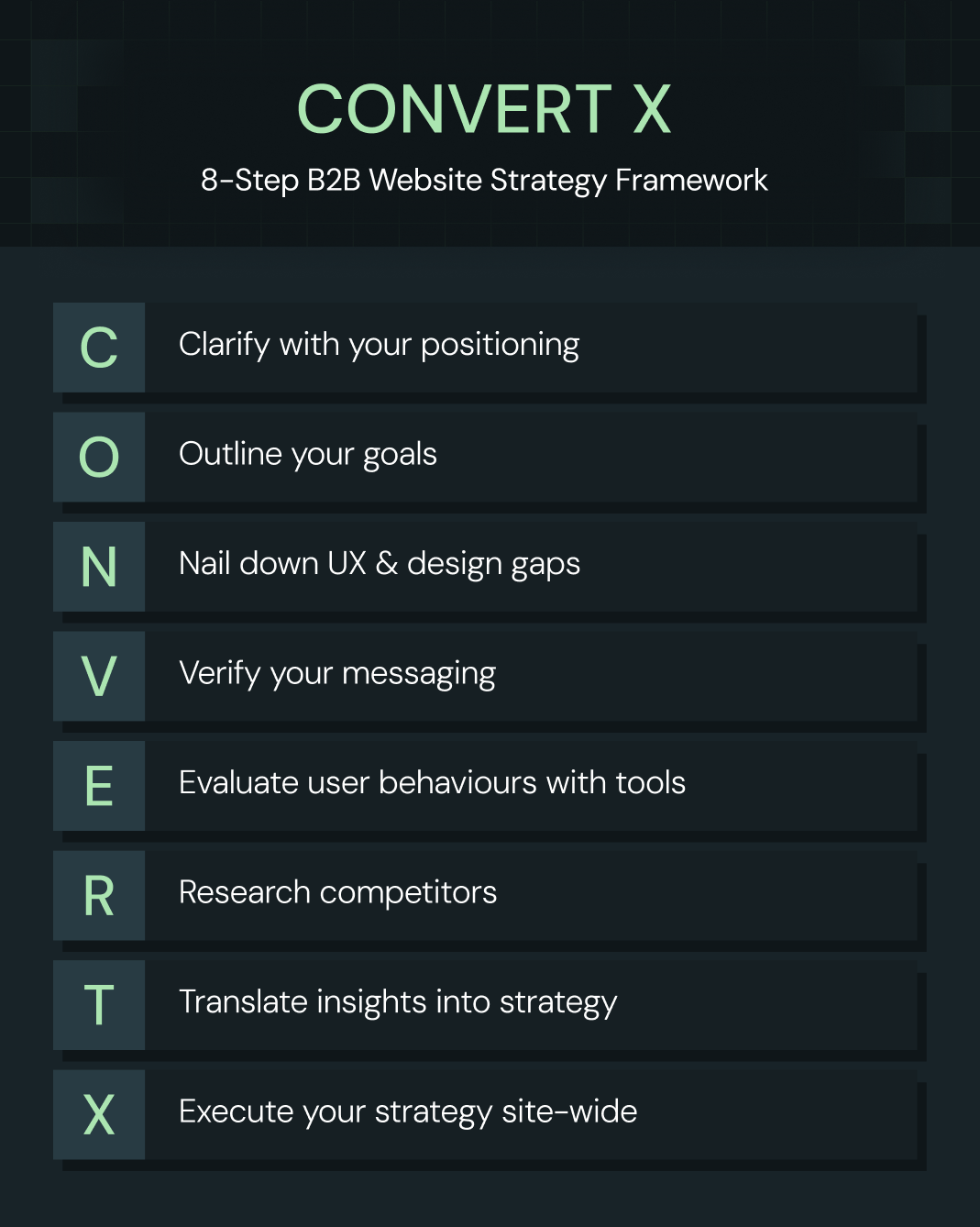
1. Clarify your positioning
Soon after we onboard a client, we send them a detailed brand positioning and messaging questionnaire to know them inside out. The key is to know everything about their product, current messaging, competitors, target market, ICP, and goals for the new website.
Next, we use the classic ‘Onliness statement’ from Marty Neumeier to create the positioning statement. A positioning statement tells you who you are and why you matter to your target audience.

It serves as the north star for website strategy, guiding you to take specific steps while ensuring you stay within your lane.
Here’s an example for a social media aggregator brand:
- WHAT: The only social media aggregator platform
- HOW: That auto-moderates and aggregates content from 20+ social media platforms in real time
- WHO: For B2B and B2C brands
- WHERE: In the US, UK and EU regions
- WHY: Who wants to increase their website engagement
- WHEN: At a time when manual content moderation is time-consuming
2. Outline your goals
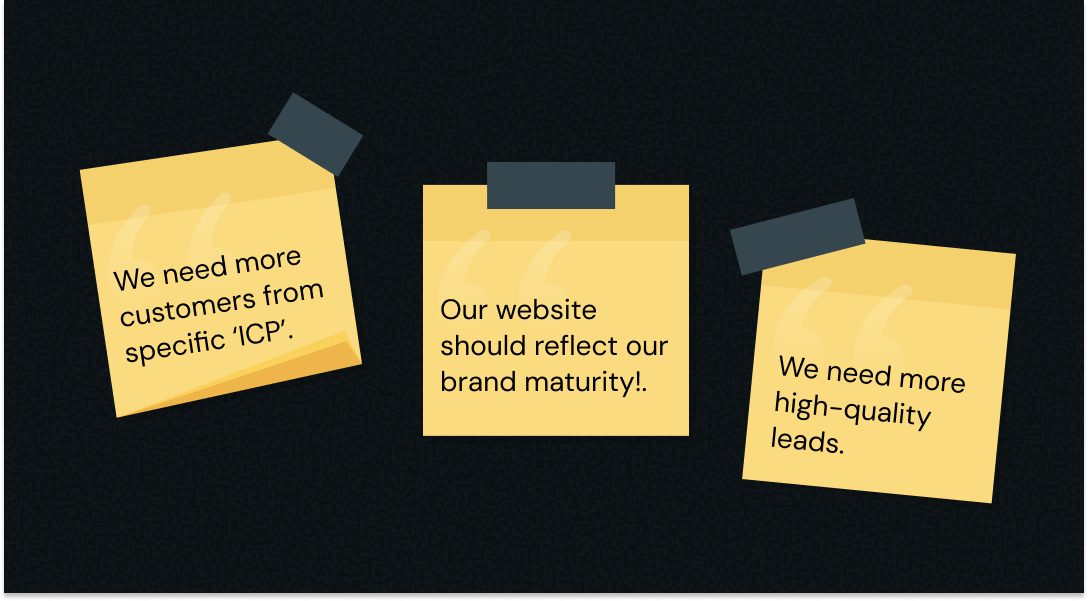
What are your goals behind this revamp? What problems are you trying to solve? Most often, our clients say things like:
“We need more customers from specific ‘ICP’.”
“Our website should reflect our brand maturity!”
“We need more high-quality leads.”
While these are high-level goals, they are clues that help you trace the thread back to the root spool.
For instance, when a website has high bounce rates, it usually points to a UX issue.
Similarly, a website lacking personality often stems from vague messaging and amateurish design.
Bookmark these goals and let them lead your way!
3. Nail down UX & design gaps
Is your current website design and UI capable enough to attract and retain the interest of your ICP? The answer isn’t always as straightforward as you think!
Take the case of Tagalys, one of our SaaS clients in the e-commerce space. Their ICP was fashion-forward European brands, but their website had a corporate SaaS look and feel. This disconnect was costing them conversions.
At ThunderClap, we run a UI & design audit to catch these issues. Our checklist covers major UI, design and accessibility standards like:
- How intuitive is the website?
- Does the content flow logically?
- How good are the CTA placements?
- How does each page guide the user through the funnel?
- Is the page easily navigable?
- Does the stylescape reflect your brand maturity and personality?
- Are the illustrations and visuals generic or brand-specific?
- Is the website visually consistent?
- Does it look boxy and templatized?
- Does it resonate with your target audience?
- Do the images have Alt Text descriptions?
- Does the website comply with WCAG 2.1 (AA) standards

4. Verify your messaging
The core idea behind a messaging audit is to check if you are communicating your product’s value in your customer’s language and weaving it through your website.
But the truth is, not many brands get it right. In fact, vague messaging hurts more than a mediocre product.
One of our recent DevOps projects revolved around this: a promising product from EX-MAANG founders with vague product pages, leading to low conversions. Post revamp, their website engagement 10x'd!
We used ThunderClap's 6-step messaging audit template, the CERTTN (Clarity, Explain, Resonate, Tie, Trust, Next Step) framework, to identify this issue. It helps you check if the webpage:

5. Evaluate user behavior with tools
At ThunderClap, data is the ultimate truth. All audit findings are just “what ifs” unless backed by real user data. Audits are based on industry standards and expert judgment, but only actual user behavior confirms what’s really happening.
For example, an audit might flag a fragmented user journey, but heatmaps and session recordings are what confirm it.
Some of the major user-behaviour tools we use include:
1. Google Analytics: Gives quantitative data on how users interact with your website. It throws light on the traffic volume, traffic sources, engagement metrics, top-performing pages, and conversion rates.

2. MS Clarity: Shows how users interact with your website through heat maps and session recordings. It helps you spot issues with your overall navigation, content hierarchy, and effectiveness, CTA performance, and website sections and elements.

- Check out the complete list of ThunderClap's handpicked CRO tools for high conversions here.
6. Research competitors

Positioning helps you stay grounded to who you truly are. Website audits and user data reveal what’s working and what’s not. But it is a competitor analysis that reveals how the market truly perceives you.
It tells you whether you're in a league of your own or just another pea in a pod. And according to Wynter’s latest study, if you belong to the latter group, you lose the battle before you start. Why? Because the average B2B buyer has time to demo only 3 vendors, and you can’t be in that list if your website looks like a rehash of 100 other websites out there.
At ThunderClap, we follow a 5-step competitor analysis process to prep our clients for category leadership:
Step 1: Find your promoters and understand how you stand in the current market through surveys and interviews.
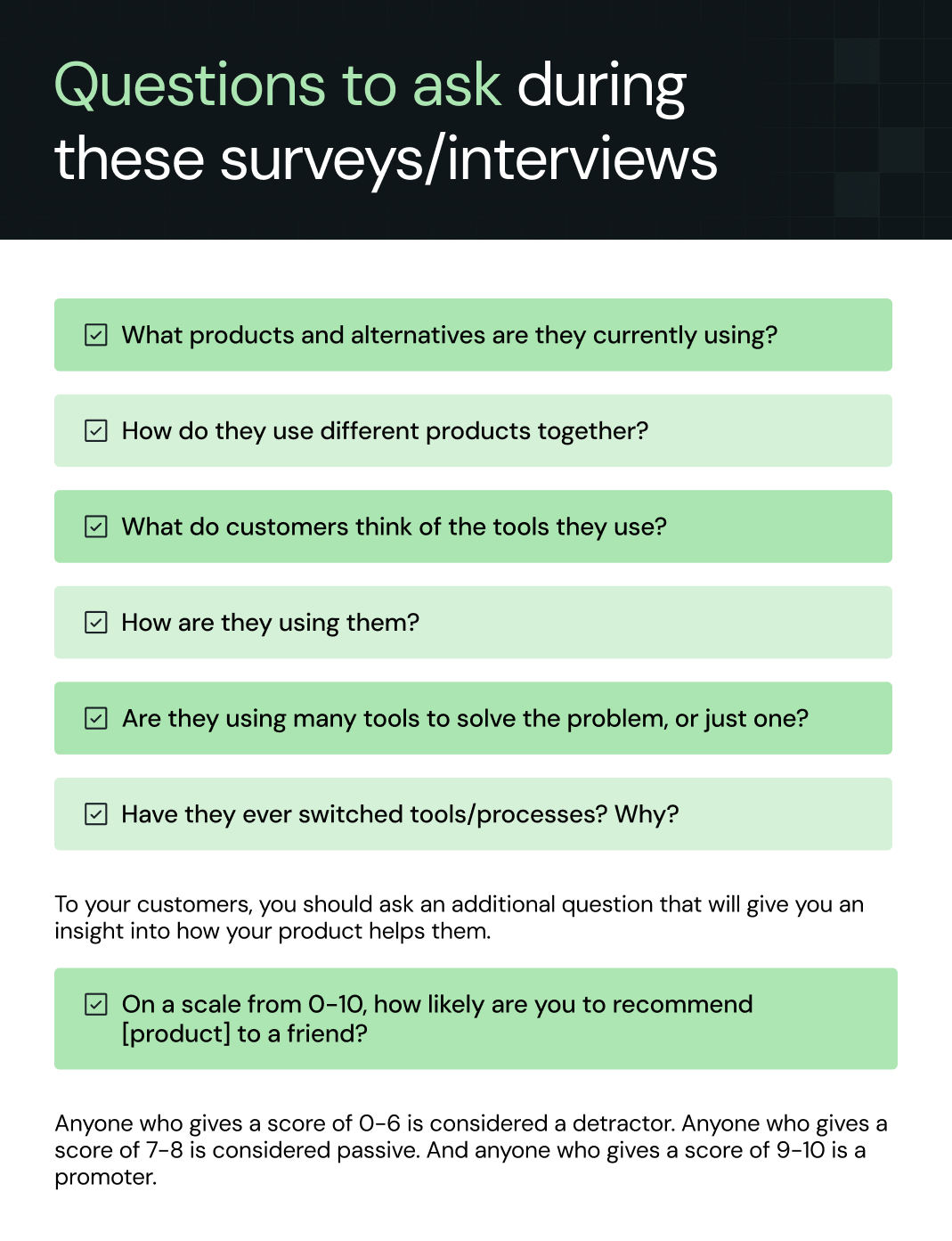
Step 2: Analyze your competitors across parameters like UI/Design, UX, pricing, messaging, CTAs, resources, social proof and other key observations.

Step 3: Read reviews on platforms like G2, Capttera and TrustPilot to know what people are saying about your competitors.
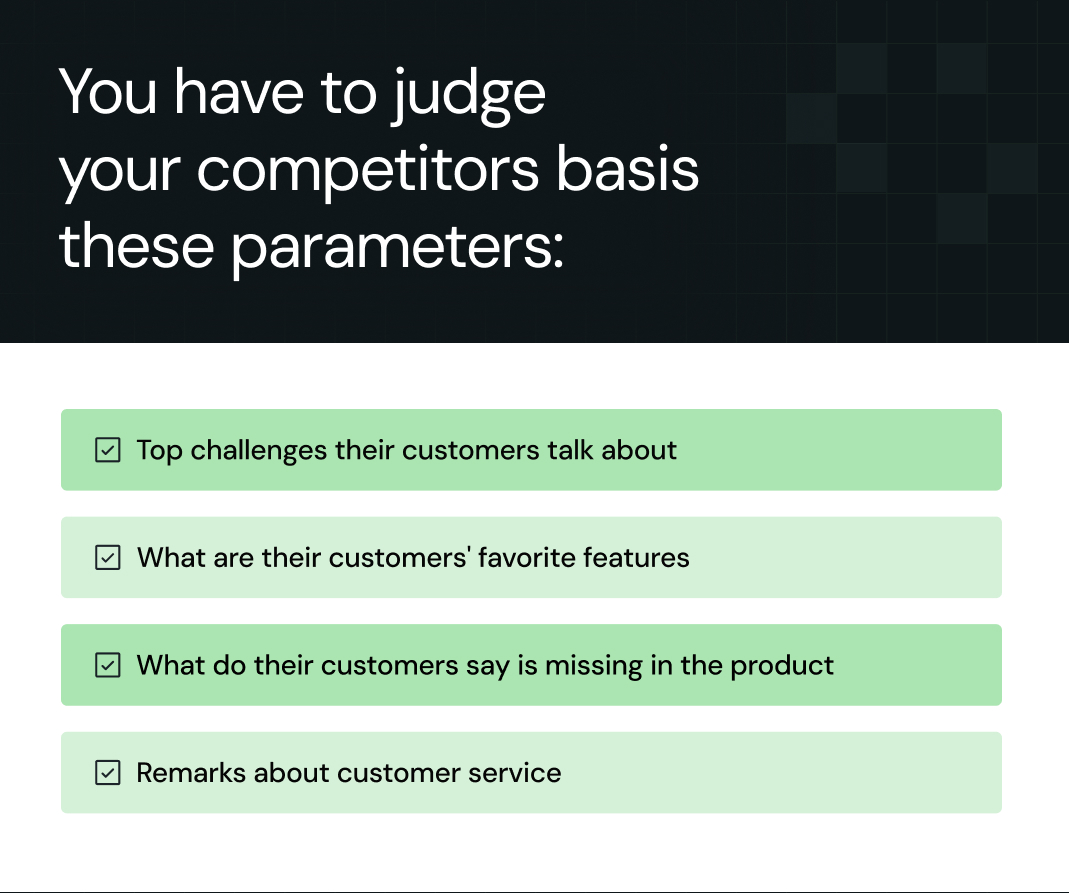
Step 4: Create a gap statement by comparing what competitors lack with what you can do better.
Example: Despite a crowded market of Webflow and website revamp agencies, most fail to connect website transformation with real business outcomes—leaving a gap in ROI–focused, B2B-specialized web solutions (ThunderClap)
Step 5: Define a new positioning by combining your gap statement and onliness statement.
Framework: [Brand Name] is a [category or type of solution] for [target audience] who want to [core outcome/goal they care about], by [key differentiator or how you uniquely deliver value], unlike [primary alternatives/competitors].
Example: ThunderClap is a website revamp partner for mid-market and enterprise B2B product companies ($10M+ revenue, 100–1,000 employees, SaaS, FinTech) in India, the US, or the UK who want to evolve their positioning, expand, or respond to market pressure, by building conversion-focused, differentiated, premium B2B websites backed by a proven process, in-house marketing experts, and international talent, unlike generic design agencies or one-size-fits-all web vendors.
7. Translate insights into strategy
At ThunderClap, we call this step the ‘false finish’. Why? Because this is where most brands stop short. They draw conclusions about what’s working and what can be made better, but fail to translate them into a cohesive goal with actionable steps.
{{specficService}}
You can avoid this pitfall by following these rules of thumb:
Create a prioritization list
Multiple audits and competitor analysis will leave you with a laundry list of fixes. But the truth is, you can’t fix everything, and you shouldn’t bother to. Instead, prioritize strategically by focusing on things that move the needle the most.
A prioritization list tells you which tasks you must do now, which can wait, and which are not worth the effort.
Here’s an example of a prioritization list for a website that’s targeting the wrong ICP but now wants to get more leads from the right one:
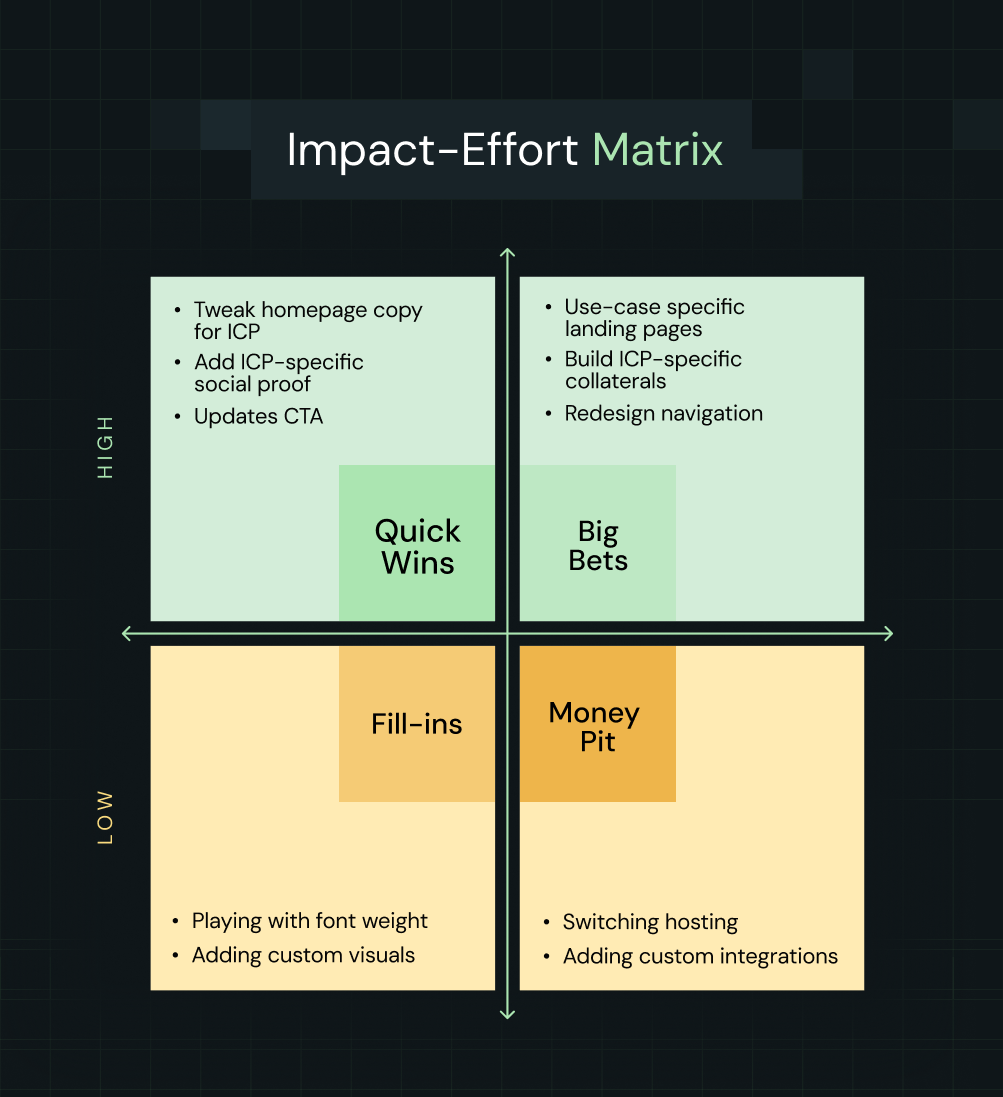
Turn your priorities into trackable outcomes
Once you set your priorities straight, convert them into trackable outcomes. We use the standard ‘SMART’ (Specific, Measurable, Achievable, Relevant and Time-bound) framework for this.
Here’s how the tasks from the high-impact-low-effort quadrant above can look as SMART goals:
8. Execute your strategy site-wide
The prioritization list gives you an idea about whether you need a complete revamp or a partial overhaul. But one thing to focus on, no matter the type of revamp you plan, is coherence. Whatever you do, ensure it's applied across the entire website, not just your homepage or money pages, whether it's design or copy changes.
Why? Because buyers come to you via multiple channels and if the things you claim don’t add up, you’ll lose credibility.
Imagine an enterprise buyer’s plight when the landing page promises enterprise-grade security, but the pricing/product page tells a different story. They get confused and are forced to walk away!
Here are some ways to avoid this:
- Create a style and design guide for verbal and visual consistency
- Review and make changes to your existing pages before the rollout
- Soft launch first to catch errors and inconsistencies
- Track key metrics after launch to monitor engagement, clicks, and conversions.
Ways to optimize your website for the 2025 B2B buyer
The modern buyer is no longer a damsel in distress waiting to be saved by chivalric salespeople. Understanding this shift is crucial for creating a website strategy that effectively serves them. Here are some ways to cater to their needs better:
Offer more self-serve experiences
Self-serve is no longer a nice-to-have as buyers prefer exploring your product on their own. As sellers, you should enable them through self-serve options like interactive demos, sandbox environments and free trials. Keep them ungated or ask only the basic details to reduce friction and avoid buyers from backing out.
Let social proof take the wheel
Buyers’ distrust in vendor websites grew from 6% in 2023 to 9% in 2024. The old ‘we are the best’ narrative doesn’t make the cut anymore. Use third-party validations, including reviews, case studies, and trust badges on websites to regain credibility.
Tie your messaging to buyer priorities
According to G2’s Buyer Behaviour Report, the modern buyer’s top priorities include security, integrations and ROI impact (C-suite). Addressing these right from the hero section can help you differentiate early and build trust faster.
Switch to a scalable website builder
With the ever-evolving buyer behavior, being agile sellers is non-negotiable. Buyers expect you to meet their expectations quickly, whether that’s refining your messaging or enabling self-serve options.
Without a scalable, enterprise-ready website builder like Webflow, even small changes can snowball into long dev cycles and higher operational costs.
{{specficBlog}}
Closing Thoughts
You can easily refine your B2B website strategy and optimize it for 2025 buyers by following ThunderClap’s CONVERTX framework mentioned above. But while doing it inhouse ensure you don’t fall for the following pitfalls:
- Static thinking: This means treating your new website strategy as something set in stone rather than a living framework that needs constant updating.
- Tunnel vision: Pushing buyer outcomes to the back burner just because you are too attached to your product features.
- Copycat syndrome: That’s when you copy your competitors to the point where nobody would notice if you swapped logos with them. We see it with our clients all the time, and we even developed a test to help them combat it. Read more about it here.
If this feels overwhelming, outsourcing your website strategy is a smart move. Just make sure to pick a website design agency with the expertise to go beyond cookie-cutter templates.
And if ThunderClap seems like a promising option based on our website strategy framework, book a call with us right away! We’ll walk you through everything you need to know from our process to the results we’ve achieved for similar brands!
FAQs
1. What is a B2B website strategy?
A website strategy is a plan that explains how to use your website to achieve your business goals. It defines how different website components, such as messaging, copy, design, and stylescape, effectively contribute to specific objectives like generating leads, building brand authority, or boosting conversions
2. How to measure my website’s performance?
Some of the KPIs to measure website performance include:
- Traffic volume: How many visitors visited the website over a period of time?
- Traffic sources: Are they coming from organic, paid, social media, or other channels?
- Time on website: How much time did they spend on the website? This usually helps gauge engagement and content relevance.
- Clickthrough rates for CTAs: How many visitors clicked on the CTAs?
- Bounce rates: How many visitors left the website after viewing a single page or with minimal interaction?
- Conversion rate: How many visitors completed the desired action, like starting a trial, downloading an e-book, etc.
3. Why should you have a B2B website strategy in 2025?
More than 97% B2B buyers still consider websites as an important touchpoint. However, with stiff competition and growing skepticism towards vendor websites, you need a proper website strategy to stand out and increase conversions.




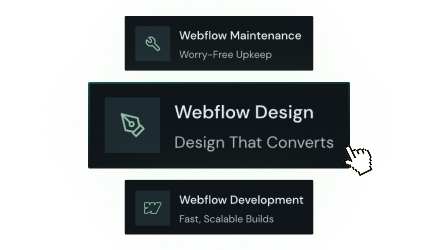
.png)



Interested in seeing what we can do for your website?


















